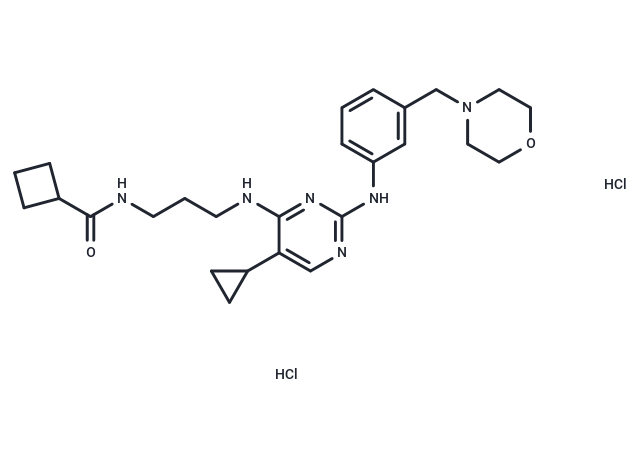Shopping Cart
- Remove All
 Your shopping cart is currently empty
Your shopping cart is currently empty

MRT 67307 dihydrochloride is a dual inhibitor of the IKKε and TBK-1 with IC50s of 160 and 19 nM, respectively. MRT67307 dihydrochloride also inhibits ULK1 and ULK2 with IC50s of 45 and 38 nM, respectively. MRT67307 dihydrochloride also blocks autophagy in cells.

| Pack Size | Price | Availability | Quantity |
|---|---|---|---|
| 5 mg | $52 | In Stock | |
| 10 mg | Inquiry | In Stock | |
| 50 mg | Inquiry | In Stock | |
| 1 mL x 10 mM (in DMSO) | $67 | In Stock |
| Description | MRT 67307 dihydrochloride is a dual inhibitor of the IKKε and TBK-1 with IC50s of 160 and 19 nM, respectively. MRT67307 dihydrochloride also inhibits ULK1 and ULK2 with IC50s of 45 and 38 nM, respectively. MRT67307 dihydrochloride also blocks autophagy in cells. |
| In vitro | MRT 67307 dihydrochloride inhibits IKKϵ and TBK1 with IC50 of 160 and 19 nM when assayed at 0.1 mM ATP in vitro, but did not inhibit IKKα or IKKβ even at 10 μM[1]. MRT 67307 dihydrochloride (2 μM) prevents the phosphorylation of IRF3 in bone-marrow-derived macrophages (BMDMs). MRT 67307 dihydrochloride (2 μM) dose not suppresse the activation of JNK or p38 MAPK by poly(I:C)[1]. MRT 67307 dihydrochloride (1 nM-10 μM) prevents the production of IFNβ in macrophages[1]. MRT 67307 dihydrochloride (10 μM) is sufficient to reduce phospho-ATG13 to control levels[2]. MRT 67307 dihydrochloride (10 μM) blocks autophagy in mouse embryonic fibroblasts (MEFs)[2]. MRT 67307 dihydrochloride (5 µM; 4 h) abrogates TBK1/IKKε-induced CYLD phosphorylation in 293T cells[3]. |
| Molecular Weight | 537.53 |
| Formula | C26H38Cl2N6O2 |
| Cas No. | 1781882-89-0 |
| Smiles | O=C(C1CCC1)NCCCNC2=NC(NC3=CC=CC(CN4CCOCC4)=C3)=NC=C2C5CC5.Cl.Cl |
| Relative Density. | no data available |
| Storage | Powder: -20°C for 3 years | In solvent: -80°C for 1 year | Shipping with blue ice. | |||||||||||||||||||||||||||||||||||
| Solubility Information | DMSO: 82.8 mg/mL (154.04 mM), Sonication is recommended. | |||||||||||||||||||||||||||||||||||
Solution Preparation Table | ||||||||||||||||||||||||||||||||||||
DMSO
| ||||||||||||||||||||||||||||||||||||

Copyright © 2015-2025 TargetMol Chemicals Inc. All Rights Reserved.